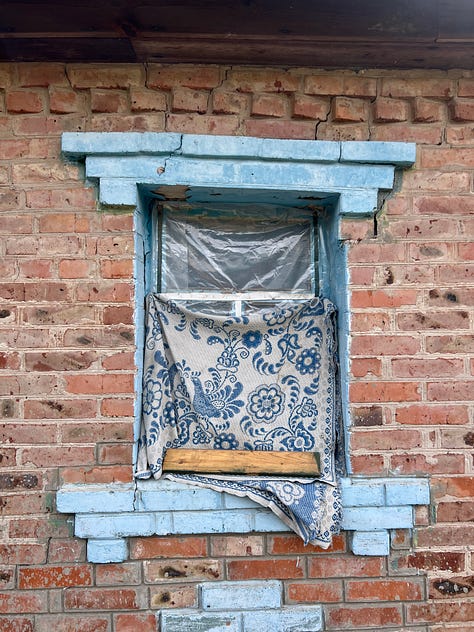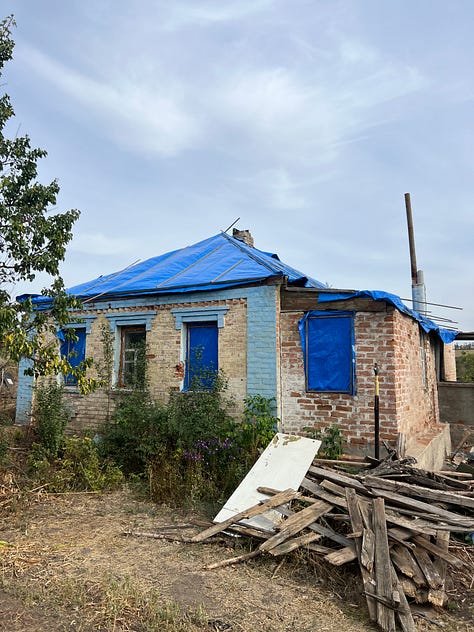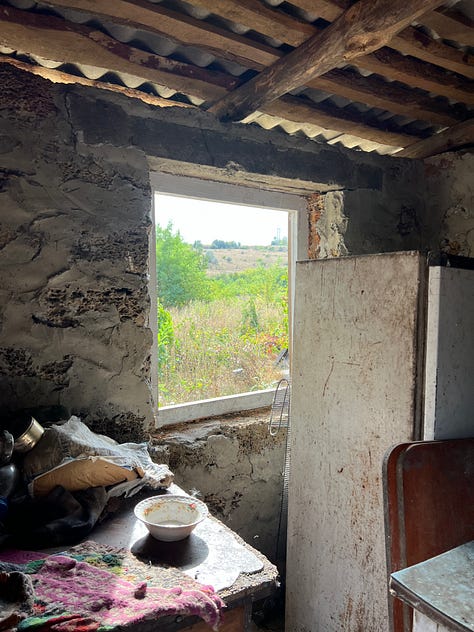The End of Summer
Over the course of this summer, we have continued to work on our repairs scheme, focussing our efforts on Slatyne, Derhachi, and Tsyrkuny. In our last newsletter, we wrote about Diadia Kolia and his sister Liuba, whose house was destroyed by a glide bomb and now live in an outhouse with their elderly mother, as well about as Raisa and Malak, a couple from the destroyed Kharkiv neighbourhood of Saltivka, who are now based in Tsyrkuny and have been living without windows for two years. These are just two of the families who we have been able to support this summer, thanks to your continued donations and support. With the Russian advance on Kharkiv having frozen, we are hopeful that we will be able to increase the pace of our repairs over the coming months leading up to winter. Though there has been an increase in attacks on the villages we work in, with a few notable exceptions (Prokhody and Rus’ka Lozova, in particular), the situation in most has thankfully calmed down considerably. People continue to return home in large numbers. Most are motivated by the huge decrease in support from the Ukrainian government for internally displaced people. Villages like Slatyne continue to exist in a strange limbo: on the one hand, they are more alive than they have been since February 2022, with shops and cafes reopening practically every day. On the other, they remain in a state of flux, with the close proximity of Russian troops meaning that there is no possibility for certainty. Nonetheless, people survive, as best they can, more exhausted than ever, but with no choice but to keep moving forward.
We have also decided to expand our work to a different area of the Kharkiv region. Earlier in the summer, we drove through a village called Kam’ianka, which is situated on the border of Kharkiv and Donetsk Oblasts. It’s hard to put into words quite how hellish it is there. Having spent two years working continually in the same selection of villages, and seeing constant progress and improvements, it was heart-breaking to remember quite how devastated so many communities still are. Like most of the other villages we work in, Kam’ianka was occupied for the first months of the war, before being liberated two years ago. The occupation of the village was particularly brutal, with every single house having been lived in by Russian soldiers and not a single one left undamaged. Since liberation in September 2022, the village has been largely forgotten. It is an almost-three-hour drive away from Kharkiv, meaning that volunteer groups tend not to work there. With a pre-war population of 1200, during occupation just five families, comprising a total of 16 people, remained. Currently, there are forty households living in the village, totalling eighty people. Most of the village still has no electricity, and there is no gas provision at all. Beginning a project there seemed like an impossible feat, given the difficulty in accessing the village, however we are pleased to announce that, in collaboration with the Ukrainian charities BASE UA and East SOS, we are this month preparing repairs to ten houses in the village, including all those lived in by children. We will be providing windows and doors, whilst BASE UA and East SOS will be repairing roofs and other essential aspects of the homes. We hope very much that this will be the beginning of a longer running project in Kam’ianka, and that you will support us in making that happen.






As well as our repair work, we have also this month provided protective equipment to the police force in Myrnohrad, a city in the Donetsk region which is now just four kilometres from the frontline and which has, over the summer, become one of the hottest spots in the entire war. This equipment, specifically helmets and protective vests, will allow the police to carry out evacuations as safely as possible. We received this request via the sister of one of our volunteers in Ukraine, who is a member of the police force in question, and who now spends her time helping the elderly and infirm to evacuate both from Myrnohrad and the surrounding villages. As the Russian advance on that area of the front continues to move at a quick and steady pace, her work is vital. At KHARPP, we have always tried to work under the principle of supporting both those who leave, and those who stay behind. In this case, our hope is to help not only those who are leaving, but those who are risking their lives to help them to do so.
I would like to end this newsletter with a tribute to David Knowles, a friend to KHARPP, and to all of Ukraine, who passed away earlier this month, aged only 32. I know that many of our readers and supporters heard about our work through the Telegraph’s Ukraine: The Latest podcast, which David founded and presented, on a near-daily basis for over two years. Last winter, David invited me to speak on the podcast, and the resulting interview led to the largest influx of donations we have ever seen. Still, on a near-weekly basis we receive emails from supporters saying that they found our work via the podcast. Following that interview, David stayed in touch. He always checked in on our team, and the communities we support, and KHARPP ended up being featured several more times on the show. He had planned to come to Kharkiv and go around the villages we support, and to follow up on the families who were supported with the initial load of Telegraph-related donations. From those initial donations alone, we repaired over 60 houses. With this being the impact of just one of the hundreds of podcast episodes which David organised and presented, it is impossible to imagine how many lives he must have transformed. We are so grateful to him, and want to send all our love and support to his family, friends, and colleagues.


In a rapidly darkening world, you bring light. Thank you!
❤️to your all . Money to follow when I get paid ❤️